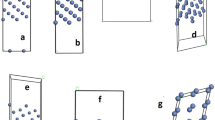Abstract
Embrittlement by the segregation of impurity elements to grain boundaries is one of a small number of phenomena that can lead to metallurgical failure by fast fracture1. Here we settle a question that has been debated for over a hundred years2: how can minute traces of bismuth in copper cause this ductile metal to fail in a brittle manner? Three hypotheses for Bi embrittlement of Cu exist: two assign an electronic effect to either a strengthening3 or weakening4 of bonds, the third postulates a simple atomic size effect5. Here we report first principles quantum mechanical calculations that allow us to reject the electronic hypotheses, while supporting a size effect. We show that upon segregation to the grain boundary, the large Bi atoms weaken the interatomic bonding by pushing apart the Cu atoms at the interface. The resolution of the mechanism underlying grain boundary weakening should be relevant for all cases of embrittlement by oversize impurities.
This is a preview of subscription content, access via your institution
Access options
Subscribe to this journal
Receive 51 print issues and online access
$199.00 per year
only $3.90 per issue
Buy this article
- Purchase on Springer Link
- Instant access to full article PDF
Prices may be subject to local taxes which are calculated during checkout



Similar content being viewed by others
References
Gray, J. L. Investigation into the consequences of the failure of a turbine-generator at Hinkley Point ‘A’ power station. Proc. Inst. Mech. Eng. 186, 379–390 (1972)
Hampe, W. Beiträge zu der Metallurgie des Kupfers. Berg-. Hütten- u. Salinenwesen 23, 93–137 (1874)
Haydock, R. The mobility of bonds at metal surfaces. J. Phys. C 14, 3807–3816 (1981)
Messmer, R. & Briant, C. L. The role of chemical bonding in grain boundary embrittlement. Acta Metall. 30, 457–467 (1982)
Sutton, A. P. & Vitek, V. An atomistic study of tilt grain boundaries with substitutional impurities. Acta Metall. 30, 2011–2033 (1982)
Lawn, B. R. Fracture of Brittle solids Sect. 2.2, 2nd edn (Cambridge Univ. Press, Cambridge, 1993)
Kelly, A. & Macmillan, N. H. Strong Solids Sect. 2.3.1 (Clarendon, Oxford, 1986)
Anderson, P. M. & Rice, J. R. Dislocation emission from cracks in crystals or along crystal interfaces. Scripta Metall. 20, 1467–1472 (1986)
Rice, J. R. & Wang, J.-S. Embrittlement of interfaces by solute segregation. Mater. Sci. Eng. A 107, 23–40 (1989)
Sigle, W., Chang, L.-S. & Gust, W. On the correlation between grain-boundary segregation, faceting and embrittlement in Bi-doped Cu. Phil. Mag. A 82, 1595–1608 (2002)
Warke, W. R. in ASM Handbook Vol. 11, Failure Analysis and Prevention 861–867 (ASM International, Ohio, 2002)
Paxton, A. T., Gumbsch, P. & Methfessel, M. A quantum mechanical calculation of the theoretical strength of metals. Phil. Mag. Lett. 63, 267–274 (1991)
Kanzaki, H. Point defects in face-centred cubic lattice—I distortion around defects. J. Phys. Chem. Solids 2, 24–36 (1957)
Finnis, M. W. The energy and elastic constants of simple metals in terms of pairwise interactions. J. Phys. F 4, 1645–1656 (1974)
Jokl, M. L., Vitek, V. & McMahon, C. J. Jr A microscopic theory of brittle fracture in deformable solids: a relation between ideal work to fracture and plastic work. Acta Metall. 28, 1479–1788 (1980)
Finnis, M. W. The theory of metal–ceramic interfaces. J. Phys. Condens. Matter. 8, 5811–5836 (1996)
Sutton, A. P. & Balluffi, R. W. Interfaces in Crystalline Materials Ch. 7 (Clarendon, Oxford, 1995)
Alber, U., Müllejans, H. & Rühle, M. Bismuth segregation at copper grain-boundaries. Acta Mater. 47, 4047–4060 (1999)
Goodwin, L., Needs, R. J. & Heine, V. Effect of impurity bonding on grain-boundary embrittlement. Phys. Rev. Lett. 60, 2050–2053 (1988)
Bruley, J., Keast, V. J. & Williams, D. B. An EELS study of segregation-induced grain-boundary embrittlement of copper. Acta Mater. 47, 4009–4017 (1999)
Muller, D. A. Why changes in bond lengths and cohesion lead to core-level shifts in metals, and consequences for the spatial difference method. Ultramicroscopy 78, 163–174 (1999)
Duscher, G., Chisholm, M., Alber, U. & Rühle, M. Bismuth-induced embrittlement of copper grain boundaries. Nature Mater. 3, 621–626 (2004)
Özkaya, D., Yuan, J., Brown, L. M. & Flewitt, P. E. J. Segregation-induced hole drilling at grain-boundaries. J. Microsc. 180, 300–306 (1995)
Saqi, M. A. S. & Pettifor, D. G. Role of impurity elements in metal–metal bond strengths. Phil. Mag. Lett. 56, 245–249 (1987)
Powell, B. D. & Mykura, H. The segregation of bismuth to grain boundaries in copper-bismuth alloys. Acta Metall. 21, 1151–1156 (1973)
Kresse, G. & Furthmüller, J. Efficient iterative schemes for ab-initio total energy calculations using a plane wave basis set. Phys. Rev. B 54, 11169–11186 (1996)
Rice, J. R. Dislocation nucleation from a crack tip: an analysis based on the Peierls concept. J. Mech. Phys. Solids 40, 239–271 (1992)
Acknowledgements
Financial support was provided by EPSRC.
Author information
Authors and Affiliations
Corresponding author
Ethics declarations
Competing interests
The authors declare that they have no competing financial interests.
Rights and permissions
About this article
Cite this article
Schweinfest, R., Paxton, A. & Finnis, M. Bismuth embrittlement of copper is an atomic size effect. Nature 432, 1008–1011 (2004). https://doi.org/10.1038/nature03198
Received:
Accepted:
Issue Date:
DOI: https://doi.org/10.1038/nature03198
This article is cited by
-
Inter-granular and Intra-granular Crack Behavior in Mg Bicrystal of [\(1\overline{2 }10\)] Symmetric Tilt Grain Boundary: LEFM Prediction and Atomic Simulation
Metallurgical and Materials Transactions A (2023)
-
Computing grain boundary diagrams of thermodynamic and mechanical properties
npj Computational Materials (2021)
-
Understanding solute effect on grain boundary strength based on atomic size and electronic interaction
Scientific Reports (2020)
-
Learning grain boundary segregation energy spectra in polycrystals
Nature Communications (2020)
-
Observations of grain-boundary phase transformations in an elemental metal
Nature (2020)
Comments
By submitting a comment you agree to abide by our Terms and Community Guidelines. If you find something abusive or that does not comply with our terms or guidelines please flag it as inappropriate.



